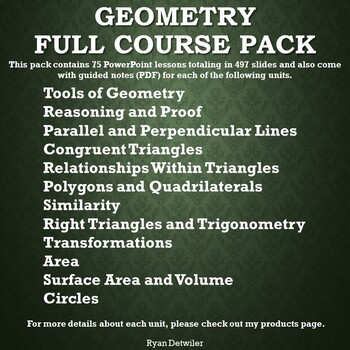Geometry Full Course Pack
- Zip
Description
Attached you will find the following 75 lessons and guided notes totaling in 496 instructional slides! Savings of 75 cents per lesson!
Tools of Geometry
Nets and Drawings for Visualizing Geometry
Points, Lines, and Planes
Measuring Segments
Measuring Angles
Exploring Angle Pairs
Basic Constructions
Midpoint and Distance in the Coordinate Plane
Perimeter, Circumference, and Area
Reasoning and Proof
Patterns and Inductive Reasoning
Conditional Statements
Biconditionals and Definitions
Deductive Reasoning
Reasoning in Algebra and Geometry
Proving Angles Congruent
Parallel and Perpendicular Lines
Lines and Angles
Properties of Parallel Lines
Proving Lines Parallel
Parallel and Perpendicular Lines
Parallel Lines and Triangles
Equations of Lines in the Coordinate Plane
Slopes of Parallel and Perpendicular Lines
Congruent Triangles
Congruent Figures
Triangle Congruence by SSS and SAS
Triangle Congruence by ASA and AAS
Using Corresponding Parts of Congruent Triangles
Isosceles and Equilateral Triangles
Congruence in Right Triangles
Congruence in Overlapping Triangles
Relationships Within Triangles
Midsegments of Triangles
Perpendicular and Angle Bisectors
Bisectors in Triangles
Medians and Altitudes
Polygons and Quadrilaterals
The Polygon Angle-Sum Theorem
Properties of Parallelograms
Proving That a Quadrilateral is a Parallelogram
Properties of Rhombuses, Rectangles, and Squares
Conditions for Rhombuses, Rectangles, and Squares
Trapezoids and Kites
Polygons in the Coordinate Plane
Applying Coordinate Geometry
Similarity
Ratios and Proportions
Similar Polygons
Proving Triangles Similar
Similarity in Right Triangles
Proportions in Triangles
Right Triangles and Trigonometry
The Pythagorean Theorem and Its Converse
Special Right Triangles
Trigonometry
Angles of Elevation and Depression
Transformations
Translations
Reflections
Rotations
Compositions of Isometries
Congruence Transformations
Dilations
Similarity Transformations
Area
Areas of Parallelograms and Triangles
Areas of Trapezoids, Rhombuses, and Kites
Areas of Regular Polygons
Trigonometry and Area
Circles and Arcs
Areas of Circles and Sectors
Surface Area and Volume
Space Figures and Cross Sections
Surface Areas of Prisms and Cylinders
Surface Areas of Pyramids and Cones
Volumes of Prisms and Cylinders
Volumes of Pyramids and Cones
Surfaces Areas and Volumes of Spheres
Circles
Tangent Lines
Chords and Arcs
Inscribed Angles
Circles in the Coordinate Plane
Locus, A Set of Points
PowerPoint lesson with guided notes.
I use an interactive whiteboard to write over each slide and save the finished notes as a PDF to post so that absent students can still get their notes.
I also print the guided notes to hand out to students.
These are made for a 50 minute class period and designed to allow time afterwards for students to practice.


